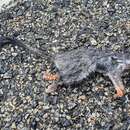fr
noms dans le fil d’Ariane


Perception Channels: tactile ; chemical
Brush-tailed phascogales occur are widespread but occur at low densities. Populations may be in decline but the causes are unknown. Preferred forest habitat is being destroyed and fragmented for agriculture, timber, firewood production, and mining (Nowak, 1999). Also, the introduction of feral species such as red fox and domestic cats have a negative influence on Phascogale tapoatafa populations as these two feral species act as predators. As a result, brush-tailed phascogales have disappeared from approximately half of their original range (Soderquist, 1995).
US Federal List: no special status
CITES: no special status
IUCN Red List of Threatened Species: near threatened
They have been known to raid chicken farms but the benefits of pest regulation seem to outweigh any negative impact they may have.
Phascogale tapoatafa is considered effective at helping to control insect and rodent pest populations since it is a natural predator of these animals.
Brush-tailed phascogales are mostly carnivorous. They hunt and kill small mammals, birds, reptiles, insects, spiders, and centipedes. They have been know to kill and eat chickens, and they generally avoid eating carrion. Phascogale tapoatafa can be arboreal and has been known to feed on the nectar of eucalyptus flowers (Nowak, 1999).
Phascogale topoatafa has a fragmented distribution, being found in various parts of Australia, including northern and southwestern Western Australia, northernmost Northern Territory, northern and southeastern Queensland, eastern New South Wales, the southern parts of Victoria, the Cape York peninsula, and isolated parts of South Australia (Nowak, 1991). There is some evidence of Phascogale tapoatafa in East Gippsland, though this has not been confirmed.
Biogeographic Regions: australian (Native )
Brush-tailed phascogales prefer eucalyptus forests in Australia for foraging grounds and nesting sites. They inhabit both humid and arid regions and dense to open forest (Nowak, 1999). Preferred habitat is open, dry schlerophyll forest with little ground cover and average rainfall between 500 and 2000mm (Strahan, 1983). Hollow trees are preferred for nesting sites (Nowak, 1999).
Terrestrial Biomes: forest ; scrub forest
Average lifespan
Sex: male
Status: captivity: 3.0 years.
Brush-tailed phascogales are squirrel-sized marsupial mice with a head and body length (excluding the tail) of between 160-230mm. Tail length varies from 170-220mm, or roughly half of body length. They weigh between 110-235 grams, the largest wild specimen known weighed 311 grams. Males tend to be heavier on average than females and this sexual dimorphism first appears at the age of eight months (Nowak, 1999). They are a deep grey color on their dorsal surface and creamy, pale white on the venter. The tail is dark black and it is characterized by having long, black, silky hairs that cover the terminal portion. These long hairs are erected during normal activity producing a "bottle-brush effect" (Nowak, 1999). The erected tail hairs is thought to distract the attention of predators away from the body (Soderquist, 1994). The ears are large and almost lacking hair. Females have eight mammae and lack a true pouch. The pouch consists of a heavy fold of skin covered with coarse, brown hair.
Range mass: 110 to 311 g.
Other Physical Features: endothermic ; bilateral symmetry
Average basal metabolic rate: 0.694 W.
Females nest in up to 30 different sites every year (Grzimek, 1990). Nests are found in hollow trees or tree stumps and under flaking bark. Competition is fierce for these limited resources Nowak, 1999). Mating takes place in early winter and males typically die after breeding at the age of 11-12 months. This is the largest known mammal in which males die after their first breeding season. It is believed that the energy expended in competition for mates leaves males susceptible to stress-induced diseases. Gestation period is roughly 30 days. Litters of seven to eight young are born and remain in the pouch for seven weeks. Young then stay in the nest until they are about 5 months old while the mother forages for food (Millis, 1999). Females raise one litter (sometimes two) in their lifetime, as they typically die in their second year. Females show dominance over males despite their smaller size and they seem to mate with a partner of their choice (MacDonald, 1984). The estrus cycle of females is roughly 40 days, and male spermatogenesis ceases before breeding while testosterone levels remain high (Millis, 1999).
Key Reproductive Features: gonochoric/gonochoristic/dioecious (sexes separate); sexual
Average gestation period: 29 days.
Average number of offspring: 6.4.
Average age at sexual or reproductive maturity (male)
Sex: male: 365 days.
Average age at sexual or reproductive maturity (female)
Sex: female: 365 days.